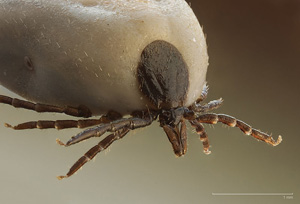Tick Borne Diseases
Lyme disease is regularly seen in humans in our area, and is recognized with increasing frequency in our horse population. Caused by a bacteria carried by deer ticks, Lyme disease can cause fevers (only during the initial phase of disease), joint swelling and soreness and shifting leg lameness. These signs could also be related to other diseases or problems, meaning the diagnosis of Lyme disease is often made while also ruling out other causes.

If we suspect that a horse has Lyme disease, a blood test can be run to assess the horse’s antibody level to the bacteria. There are 2 main tests that are used, an antibody titer that gives a general result – negative, slightly positive, moderately positive. Another test that can be used tests specific proteins on the horse’s antibody to try to assess whether there is an active or chronic infection. Testing for Lymes becomes slightly complicated because the results can show antibody that the horse has from a previous exposure to Lyme, but that may not be related to the current problem. Regardless of the test used, if treatment is initiated the horse will be treated with 4-6 weeks of the antibiotic doxycycline. In severe cases we sometimes have to begin treatment with intravenous oxytetracycline before continuing with doxycycline.
Because of the prevalence of Lyme disease in our area, we now recommend a Lyme titer be run on horses that we see for prepurchase exam to have a “baseline” value for possible comparison in the future.
Another tick borne disease is Anaplasmosis. Transmitted by deer ticks but caused by a different bacteria than Lyme disease, Anaplasmosis affects a specific white blood cell (the neutrophil) and causes high fevers, lethargy, anorexia, and swollen lower limbs, and is most commonly seen in the late summer/fall. Blood testing for Anaplasma is done slightly differently than for Lyme disease and tests for the presence of the bacteria in the blood. Treatment for Anaplasma includes intravenous oxytetracycline, anti-inflammatories to reduce fever, and supportive care until the horse begins to feel better. Treatment is continued with oral doxycycline after the horse’s fevers are controlled, for a total treatment time of 7-10 days.
To reduce your horse’s risk of exposure to ticks we recommend regular “tick checks,” especially after riding in wooded areas, and keeping grassy areas trimmed, as ticks live in tall grass.
Prevention Of Lyme Disease
Methods of preventing Lyme disease in horses include:
- Keeping the animals in general good health
- Checking the animals regularly for ticks
- Removing any discovered ticks immediately
- Using tick repellents
- Having the animals checked regularly by veterinarians
Animals residing in tick-infested regions should be examined daily, and owners should learn to use tweezers to safely remove ticks as soon as they are found.


